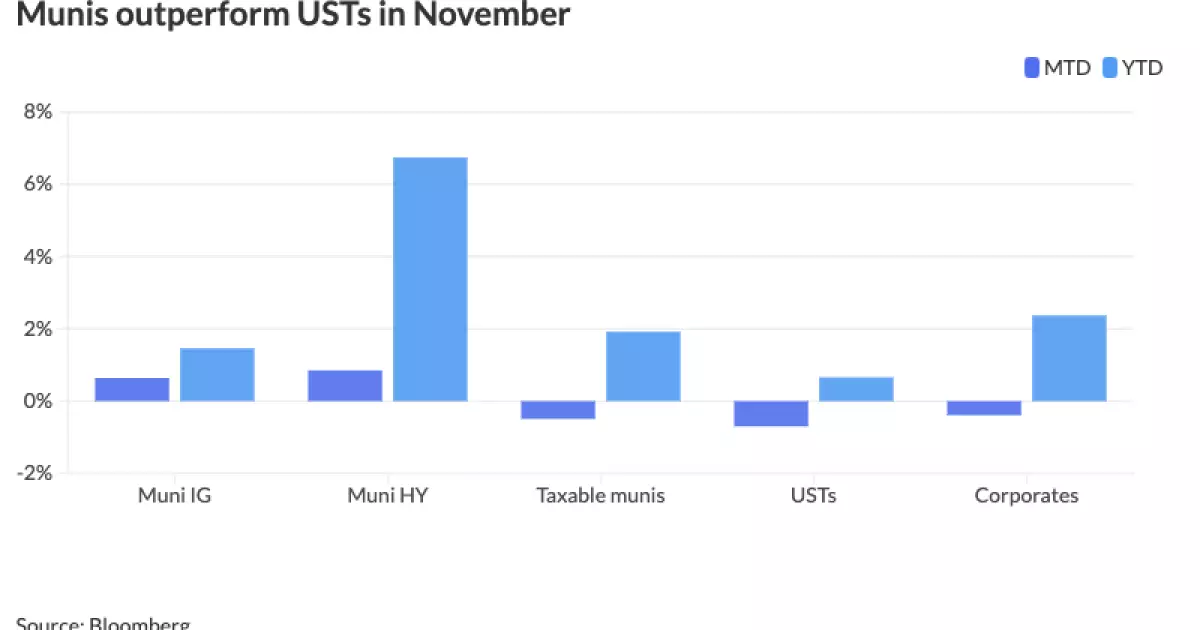The municipal bond (muni) market showcased remarkable resilience amidst a tumultuous financial environment recently. With slight movements in yields and a generally mixed performance among U.S. Treasury bonds and equities, the behavior of munis has drawn attention from investors and analysts alike. This article delves into the current state of the muni market, examining the trends, inflows, and key upcoming issuances.
The Current Market Dynamics for Munis
The recent stability of municipal bonds can likely be attributed to their unique positioning within the broader financial markets. Jeff Timlin of Sage Advisory articulates that munis tend to be less susceptible to abrupt tactical market shifts compared to U.S. Treasury securities (USTs), especially during periods of substantial market volatility like recent weeks. This observation underscores the appeal of munis as a more stable asset class offering consistent returns, positioning them as a refuge for risk-averse investors.
Despite the slight dips in yields observed over the last week, market sentiment seems relatively positive. According to Pat Luby from CreditSights, trading volume has remained robust, driven primarily by active investor participation in the primary market. Notably, the sustained inflow into municipal mutual funds has contributed to a healthier perception of the market, with reports indicating 20 consecutive weeks of inflows.
Delving deeper into the inflows, it appears that while municipal funds are still witnessing bets from investors, the volume has tapered. The latest figures show a decrease in inflows from $1.264 billion to $305 million for the week ending Wednesday. Timlin suggests this trend of more modest inflows indicates a stabilization phase in the market, which may lead to a “tight boundary” movement in future fund flows. This reduction should not be misconstrued as a negative sign; rather, it reflects a rebalancing of investor activity following an intense buying spree.
Furthermore, Luby highlights that munis have outperformed USTs and corporates, resulting in lower muni-UST ratios across various maturities. For instance, the two-year ratio stabilized at 62%, while longer durations like the 30-year stood at 82%. Such metrics suggest sustained investor interest in munis, reinforcing their reputation as a defensive asset class, particularly in periods of uncertainty.
As the Thanksgiving holiday approaches, market participants anticipate a busy week filled with significant issuance. Issuances are expected to reach approximately $8.4 billion, led by notable transactions such as the $1 billion United Airlines Terminal Improvement Projects airport system special facilities bonds. Analysts believe that this influx will be well absorbed by investors looking to capitalize on current muni offerings.
Frost Bank’s recent pricing activity for Ector County, Texas, exemplifies the opportunity in the primary market, with certificates of obligation demonstrating competitive pricing across various maturities. This trend is expected to continue, as issuers gear up to finalize deals before the holiday season. Moreover, upcoming large deals, such as the Connecticut $1.38 billion transportation bonds and the Greater Orlando Aviation Authority’s airport facilities revenue bonds, promise to draw significant interest.
Current yield curves across major data providers reveal that the muni market remains attractive in comparison to USTs. For instance, the one-year yield sits at 2.79%, with longer maturities remaining juxtaposed against traditionally higher Treasury yields. As of recent reports, the two-year UST is yielding 4.282%. This indicates that investors may find better value in munis, particularly when considering tax-exempt benefits that municipal debt offers.
In observing these trends, it’s important to note the diverging paths of munis and Treasuries, emphasizing the distinct role that municipal bonds play in investors’ portfolios. As market confidence fluctuates, the consistency in muni yields often proves to be an effective hedge against inflation and interest rate concerns that plague other asset classes.
The stability of the municipal bond market amidst broader market fluctuations paints a picture of resilience and strategic value for investors. With robust inflows, upcoming issuances, and an appealing yield curve relative to Treasuries, munis are poised to remain an integral part of investment strategies, especially for those prioritizing stability and tax efficiency. As we approach the end of the year, the demand for municipal bonds is likely to persist, reinforcing their position as a safe haven in uncertain times. Investors should remain vigilant and responsive to these dynamics to capitalize on the evolving landscape of municipal finance.

